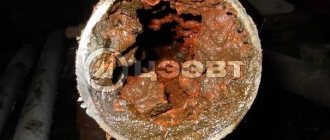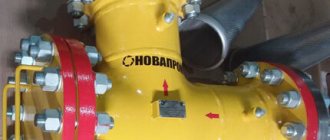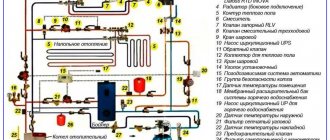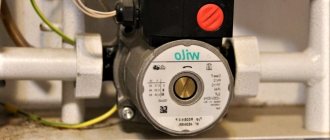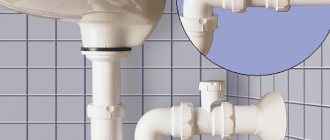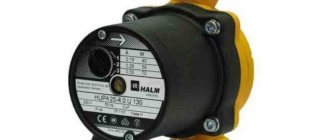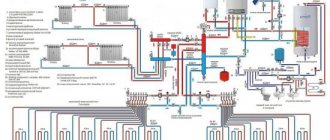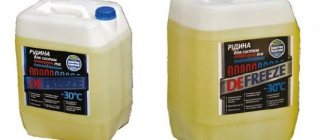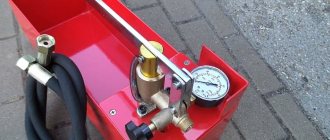Relevance of installing heating filters
What else causes changes in the composition of the coolant? Firstly, connect the make-up unit to the central water supply. In this case, mud filters for heating will retain most of the impurities.
In addition, there is another factor in the appearance of foreign elements in water. Even a carefully distilled coolant contains a certain percentage of mineral additives. As temperatures rise, it precipitates, forming limescale on the pipes. With sufficiently intense circulation, part of it enters the water in the form of particles of a fairly large fraction. An installed filter for the heating system will delay them, thereby leaving the system parameters at the proper level.
What filter elements should an autonomous heating system consist of?
- Preliminary rough cleaning . It is required to be installed when connecting to a central water supply to recharge the system. The optimal model is a sump filter in heating, in the flask of which all foreign components are collected;
- Fine cleaning . With its help, you can delay the movement of small particles whose size is less than 100 microns;
- Additional magnetic filters for heating . On their walls, made of a ferrimagnetic alloy, metallized particles remain - rust, chips from pipes, etc.
Selecting the most suitable filter models for heating must begin with a thorough analysis of each type.
Installing a dirt filter is mandatory, since even in an autonomous system with a well-treated coolant, rust from the pipes and boiler heat exchanger can get into the water.
Features of installation in the house
The process of installing a water filter for a gas boiler depends on what kind of filter we are talking about. But there is a general procedure.
Materials and tools
Before installation, you need to prepare everything you need so that the work does not take much time:
- brush for preliminary cleaning of pipes leading to the boiler;
- tool for carving plastic pipes;
- fum tape;
- tow;
- pliers;
- device for soldering plastic pipes.
All of the listed tools must be present in the arsenal during installation. You should also have on hand instructions for installing a specific type of device in front of a gas boiler.
Selecting and preparing a site before installation
The equipment is installed directly in front of the pump, since installation anywhere else would be pointless. The pipes into which the filter will cut must be free of dirt and scale, so you should first clean them with a brush or a special brush.
Important! The place where the device is supposed to be installed must be accessible for further maintenance of the device.
Design features of the equipment
The following methods for separating impurities are used in filters for heating systems:
- settling devices are based on gravitational forces - when the flow speed decreases, sedimentation of solid particles is observed,
- in mesh variations, water passes through cells of a given size. Anything larger than these holes remains in the filter,
- in magnetic models, the active element attracts metal scale and particles of similar composition.
The simplest mud settling tanks are a cylindrical body with two pipes, with a flange plug at the bottom. There are jumpers in the cavity that change the direction of water flow. Magnetic models reduce the intensity of scale formation on internal surfaces.
Modern filters for water purification in a heating system combine 2 or all principles of medium processing.
Types of devices
Based on the degree of purification, mud collectors are classified into several types.
Brass mesh oblique devices
They are optimal for local heating schemes and have a simple design. The products are equipped with threaded coupling connections, available in a variable range of sizes, which expands the possibilities of their use.
The monolithic cast brass body consists of a combination of two cylinders - horizontal and located at an angle to it. Both ends are equipped with threaded mounting couplings. At the end of the oblique cylinder there is a brass hexagonal plug sealed with a Teflon gasket. A steel mesh is located in the slope area. Before such a modification, a shut-off valve is installed to facilitate maintenance work and flushing.
To clean it, you need to turn off the coolant supply, place a container to collect liquid and dirt, unscrew the plug with a wrench and remove the mesh. The latter is treated with a polymer brush under strong pressure of water.
Cast iron oblique magnetic models
Their design is similar to the previous variation, the differences lie in the material - the plug and body are made of cast iron. The filter mesh is the same steel, it is used with a paronite gasket.
The filtration unit is complemented by a stand on which disk-shaped magnets are installed at a given interval; they are not subject to corrosion. Thanks to this rigid inclusion, two-way filtration is ensured: mechanical impurities remain in the mesh, scale and metal particles are captured by the magnetic block. High quality of coolant processing is ensured.
The installation and maintenance procedure is fully consistent with brass variations with one addition - magnetic disks also need to be washed.
Flange magnetic filters for heating systems
The modification is in many ways similar to the previous version, but it is larger in size and is designed to service larger diameter pipelines. The threaded plug in this case is replaced by a flange plug; sometimes a clogged drain hole is provided here, allowing liquid and dirt to be drained without dismantling the entire plug.
When selecting and installing such products, it is necessary to take into account the installation and operational parameters of length and height, and also provide a place for removing the plug, removing the magnetic block, and the mesh.
Subscriber mud traps
They can be horizontal or vertical, the latter being more common. The devices have an impressive service life and are easy to use. Thanks to the large internal volume, the frequency of preventive maintenance is significantly reduced.
The cylindrical body is made of steel pipe. There are nozzles with a flange on both sides. The passing coolant undergoes two stages of purification: small suspensions are retained by the mesh, before large particles are deposited under the influence of centrifugal and gravitational forces. Reliable and simple design, affordable cost contribute to the widespread use of subscriber filters in autonomous heating systems.
On the specialized market there are self-cleaning mud collectors, supplemented with an air vent - dissolved gases are separated and removed in them.
Rough cleaning. What is a sediment filter?
The coarse cleaning device is an angular mesh filter with a mesh of up to 300 µm-microns. The device is also equipped with a drain in which dirt accumulates. This product is designed to clean coolant from large and small fractions.
Design
Depending on the design, there are several types of coarse mud collectors:
- According to the method of connecting the device to the pipe. There are flanged, welded and threaded devices.
- By location on the structure. This is a horizontal and vertical device.
The mudguard is made of brass, steel and plastic. The first option will withstand elevated temperatures. A steel device wears out quickly. The plastic product can only withstand relatively low temperatures up to +90 degrees Celsius.
One type of coarse mud filter is a sediment filter. This is an improved design equipped with a flask. It is located at the bottom of the device. When a large amount of dirt accumulates on the mesh, it falls down under gravity. Thanks to this, such debris accumulates in the flask and does not end up in the radiators.
The design is also improved with a separator. Air accumulates in it and enters the circuit. When its level reaches the limit, a valve opens on top of the device. After this, the air leaves the system, which prevents the formation of air locks.
Operating principle
There is a mesh inside the filter. This element blocks the inlet through which the coolant moves. During the passage of liquid through the mud filter, medium and large sized fractions are cut off. After this they move to the outlet. Thanks to this, relatively clean coolant flows to the radiators.
Advantages
Improved designs have the following advantages:
- Thanks to the flask, there is no need to remove the device to assess its degree of fullness. The assessment is carried out visually.
- A tap is fixed at the bottom of the device. Dirty water is drained through it.
- The filter removes air from the system, which prevents rust from occurring. This extends the life of the circuit.
Installation location and features
The installation location of the device depends on which heating system it is used for. For autonomous circuits, it is mounted at branch points, on the return before connecting to the boiler and on the bypasses.
Correct operation of the device is guaranteed by correct installation. Before installing any device, the circuit is cleaned of dirt and rust.
There are special symbols on the mud pan that indicate the movement of liquid through the pipes.
The product should only be installed in accordance with this instruction.
If the mechanism is not fixed correctly, hydraulic resistance will arise inside the structure.
Attention! The mudguard provides the circular pump with protection against debris from penetrating the blades. If you refuse to use it or install it incorrectly, the likelihood of engine and impeller failure will increase.
Fine purification for water
A fine filter is an additional filter designed to remove small fractions.
Design
There are several designs of such a device:
- with metal mesh up to 5 microns;
- with a cartridge made of fabric folded in several layers;
- with polymer porous filler;
- with mineral sorbent backfill.
Device structure
Filter types:
- A metal mesh is inserted inside the device. Cell size up to 5 microns.
- A cartridge made of fabric that is folded several times.
- The cassette contains a polymer porous filler.
- Mineral sorbent backfill.
Advantages
By cleaning the fluid from dirt, the service life of the entire heating system is extended. The risk of corrosive deposits on the inner walls of pipes and radiators is reduced. This is the main advantage of the fine cleaning device.
Where is it mounted?
The fine filter is designed in such a way that its location can only be horizontal. During installation, it is necessary to install one tap behind and in front of the device so that if the device breaks down, it can be removed without draining the water from the entire system.
If the pipeline is filled with antifreeze, then installing a fine filter is not necessary, since antifreeze does not pass through it.
The installation of the mud pan is carried out along the flow of the coolant, reducing breakdowns of the heating system.
Magnetic models of mud collectors
A magnetic filter for a heating system is a device of two magnets with polar poles, which are placed opposite each other. Such a device cleans the coolant not from contaminants, but from metals.
Photo 2. Magnetic filter for cleaning heating systems from metals. Installed on a pipe.
Types of devices
The filter can be of the following types:
- Removable design. The device has two plates that are installed opposite each other. Fixation is carried out on the pipe. Among the advantages is the quick replacement of the entire device.
- Non-removable device. The shape is a pipe made of ferromagnetic alloys.
Operating principle
Installation is carried out after the sump for large debris. The element that filters small debris cannot be installed as the main link in the cleaning system, since it very quickly becomes clogged with particles of a large fraction.
The cassette filters small particles of debris, and the coolant circulates through the pipes in a purified form.
Installation rules
The device is installed strictly before entering the circulation pump. For installation, it is advisable to find a place where the cross-sections of the pipe and the filter device are identical. If the sizes differ, you can use adapters.
During installation, the device is placed vertically and secured with brackets.
Sump filter
Sump filter with air separator
This is an improved model that allows you to avoid carrying out maintenance work for a long time. The specific design of a dirt filter for heating with a sump is the presence of a flask located at the bottom. Foreign components, lingering on the metal mesh under the influence of gravity, sink to its bottom. The flask is made of heat-resistant transparent plastic, which allows you to visually monitor the degree of contamination of the element.
Often, to reduce the oxygen content in water, a separator is installed in the same housing with the filter for the heating system. As the coolant passes through the filter, air is released, which is concentrated in the upper part of the structure. When a certain pressure value is reached, the drain valve opens.
The advantages and features of installing a similar model of coarse filter for heating are as follows:
- Possibility to visually control the degree of filling of the flask. A tap is installed below to drain contaminated liquid;
- Reducing the air content in water leads to minimizing corrosion processes on steel elements of the system;
- Installation is carried out almost immediately after the heating boiler. It is in this part of the pipeline that the temperature and pressure of the coolant are maximum, which contributes to better operation of the separator.
But you need to take into account the big difference in cost. The average price of a mud filter for a heating system is about 140 rubles. At the same time, a combined model with an air separator will cost much more – up to 7 thousand rubles.
Be sure to check the material used to make the flask at the settling filter. It should be heat-resistant plastic that will not lose its shape when exposed to high temperatures.
Varieties
To reduce the risk of boiler breakdown, increase the accuracy of measuring instruments and ensure a long service life of the equipment, it is important to understand the main types of devices and choose the right one.
Polyphosphate
Polyphosphate units are considered a budget option for pre-purification and softening of water entering the boiler.
The operating principle of such a device is to pass liquid through a flask filled with special crystals. They ensure the formation of a protective film on the inner walls of the boiler and also slow down the formation of scale.
Photo 1. Polyphosphate filter for a gas boiler, filled with special crystals. They slow down scale formation.
The devices have a simple design:
- drain;
- flask;
- filler;
- lid.
The liquid enters the flask with filler through the lid, where it is passed through polyphosphate crystals. Next, it goes through the drain into the gas boiler tank.
Any device of this type requires periodic replacement of the filler - sodium salt crystals. As a matter of fact, this is the only difficulty in servicing them. The average lifespan of such a treatment plant is up to one and a half years.
Electromagnetic or magnetic for softening hard water
Electromagnetic devices are expensive, but the price is completely justified: the installation lasts a long time and allows you to obtain perfectly clean water at the output.
The principle of operation is that when the liquid passes through the flask, the salts in it disintegrate. Thus, scale will not settle on the walls of the boiler. Instead, the filter itself will be clogged with tiny salt particles, which is periodically washed.
Photo 2. Three magnetic filters for a heating system boiler; the scale in them breaks down into tiny particles.
Another characteristic is that under the influence of electromagnetic radiation, not only does the scale disintegrate into small particles, but also a thin film is formed that covers the boiler heat exchanger. Thanks to this, it remains protected and does not corrode for a long time.
We should not forget that electromagnetic and magnetic devices are different installations. At the heart of both is a magnet.
Attention! Electromagnetic devices are more powerful because they require connection to an electrical network. Ideal for gas boilers, as they perfectly soften water of any temperature. Magnetic installations are less strong and are not recommended for use with gas boilers if the water hardness is too high.
Magnetic devices consist of a metal case, inside of which there are a large number of strong magnets. Electromagnetic devices are additionally equipped with an electric drive, the operation of which allows the effect of magnets to be greatly enhanced.
Cartridge for cleaning
Cartridge devices have low throughput. The following device types exist:
- Mechanical - traps small debris. Such devices need to be cleaned frequently, and they do not soften the water.
- Coal - purify water due to activated carbon, which acts as a filler. If you do not change it in time, the water will become even more contaminated as a result of passing through the filter.
Photo 3. Four low-flow cartridge filters are needed to purify the water.
- Ion exchange cartridge devices are considered the best, as they change the hardness of water by entering into a chemical reaction with calcium and magnesium ions.
- Osmotic - allow molecules of water and gas to pass through them. This allows you to clean the liquid from metal impurities and harmful microorganisms, but it will not be possible to soften the water by installing such a filter.
- Membrane - purify water from debris and impurities, but do not soften it.
Important! Cartridge filters are not suitable for gas boilers (with the exception of ion exchange devices). They are more focused on purifying water that is intended to be drunk.
Principle of operation
The principle of operation of the filter is quite simple. Water enters the pipe and then goes into the internal cavity of the housing. And inside the body, suspended particles fall to the bottom in the form of sediment. The filter is installed inside the outlet pipe. The water passes through the filter and enters the heating system in purified form. To clean the mud trap from sediment, you need to remove the glass from the outlet pipe. The mud trap can be with a flange or threaded connection.
The sump device is a pipeline expansion unit that changes the direction of water flow, as well as filtering it with a mesh. Cutting off occurs under a special mesh, as well as the accumulation of large and medium fractions and precipitation.
The function of the mud collector is simple: it takes in contaminated water, purifies it and then removes the purified water. But it is recommended to periodically clean the lower part of the case from accumulated dirt.
But there is one nuance under which a mud filter for a heating system will work normally: the condition of a gradual increase in hydraulic resistance according to the readings of instruments on the pipeline line before and after the mud filter must be met.
What is suitable for a double-circuit boiler?
Let's start by looking at the features of a double-circuit boiler. Should the filter in front of the double-circuit boiler be some kind of special or not? Dual-circuit means that it has not one type of heating, but two. It heats the water, not only that which is in the heating system, but also that which is supplied to the house as hot water. How does this affect filter selection? Well, first of all, because the quality of the water is still potable, because... The family will use hot water in the kitchen and for bathing. This means that the quality of cleaning must be appropriate. The second feature is greater water consumption, because... it serves two purposes at once, which means the filter cleaner should be more powerful.
Therefore, for such boilers it is necessary to either install one more powerful polyphosphate filter, or combine two devices - electromagnetic and ion exchange, each for its own circuit.
How to choose a coarse filter for the heating system of a private home?
When studying this market segment, you can find the following offers:
- Fittings with bends equipped with meshes.
- Containers filled with gravel, sand, and other cleaned granules.
- Disc structures that create thin tunnels for water to pass through.
- Cartridges with fillers made of polymer threads, other volumetric devices for retaining mechanical impurities.
When choosing a suitable coarse filter for the heating system of a private home, you need to take into account the following parameters:
- Connecting dimensions for connection to a specific section of the main pipeline.
- Permissible range of temperature and pressure.
- The maximum particle sizes for which the coarse filter for the heating system is designed and its price.
It is imperative to study the manufacturer’s warranty obligations and official recommendations for routine maintenance. Cartridges are disposable products. They cannot be cleaned by washing, so a specific replacement schedule must be followed. It is compiled taking into account the volume of consumption and the degree of contamination of the liquid.
Criteria for choosing a filter for gas boilers for water
The choice of a cleaning filter must be approached with all responsibility, because the further operation of the equipment depends on it. If you have doubts about purchasing a particular device, it is better to consult with knowledgeable people or be guided by general selection rules.
- Focus on water quality and frequency of filter use. An electromagnetic cleaner that does not require disassembly and replacement of main parts is suitable for regular use. When paired with an expensive boiler, it will show maximum operating efficiency.
- For very hard and dirty coolant, it is better to use double protection and softening, focusing on different degrees of water purification.
- If your budget is limited, you can give preference to a polyphosphate filter or a cartridge filter.
- Consider the dimensions of the filter so that there is enough space for its installation.
- Buy products from trusted sellers who provide a quality guarantee for their products and the possibility of warranty service.
- Focus on well-known manufacturing companies, because... they are more difficult to counterfeit, and in the event of a breakdown, parts for such devices will be easier to find.
If you do not ignore these recommendations, you can purchase a high-quality filter with a good price-quality ratio.
Features of operating a mud filter for a heating system
The simplest product you can buy is because... it doesn't even connect to the drain. To clean the mud filter, unscrew the cap, remove and wash the mesh, and install it back. This simple operation causes difficulties when installing equipment in an inconvenient location. Frequent repetition wears out the thread and impairs the tightness of the connection. Eliminate the listed shortcomings and expand functionality with the following additions:
- The valve, connected to the sewerage system, allows servicing to be carried out “with one movement of the hand”, quickly, without disassembly.
- A rotating ring with marks reminds you of the need to wash on certain days.
- When equipped with pressure gauges and a built-in pressure maintenance device, they provide protection against pressure drops in the central supply line.
- To fully automate flushing at time intervals, a set consisting of an electric valve, a timer, and a power supply is used.
The next option, a container with a bulk filling, can be equipped with similar devices. They will make it easier to clean the filler and remove accumulated dirt.
Mud filters for heating work more efficiently. In them, washing is started as needed. It is not the indirect indicator, time, that is controlled here, but the pressure. If it rises (at the inlet), the fluid is directed along a different path. The discs unclench, rotate and are easily cleaned with a stream of water.
Mud filters for the heating system of private and country houses are quite expensive during the operational period. Some manufacturers specifically make these products with unique sizes and shapes to make it difficult to use non-original analogues.
The disadvantages of mud filters and coarse filters are noted below:
- Settling is too long a procedure. To handle large volumes of liquid, a large reservoir is needed. Accumulated bottom sediments will have to be removed.
- The previous method is not effective in relation to the smallest suspensions. Their weight is too low for sedimentation. In this case, special substances (coagulants) are used that provoke the creation of large heavy particles. The main disadvantage is the need for precise dosing of chemical compounds. Some of them are dangerous to human health.
Electromagnetic filter (water softener) to protect the heating boiler from scale and lime
An electronic device that is installed on the return line of the heating system and protects the boiler from the formation of scale and lime deposits WITHOUT the use of reagent, salt, replaceable elements (cartridges, membranes, etc.). Does not require maintenance or monitoring during operation. It works on the “set it and forget it” principle. The service life is 15-20 years. Requirements - constant operation from a 220 V network. Electricity consumption - 5 W/hour.
Anti-scale protection: magnetic filter in front of the boiler
It is the increased hardness of water that poses the greatest threat to the normal functioning of boilers, pipelines, valves, radiators, and other components. In their original (dissolved) state, salts are invisible. At low concentrations they cannot be tasted. But when heated, scale forms, which worsens the consumer characteristics of the equipment, provokes minor breakdowns and major accidents. For protection, a magnetic filter is used in front of the heating boiler, which provides:
- Exchange of hardness ions for harmless sodium compounds.
- Creation of polyphosphate shells that do not allow microscopic contaminants to adhere.
- Grinding using ultrasonic vibrations.
- Transformation of the shape of the smallest particles of scale, the formation of charges of the same name on their surface using a magnetic field.
The last option is similar in effect to the use of polyphosphates. But exposure to the field does not deteriorate the chemical composition, therefore it is suitable for treating drinking water.
The noted remark should be taken into account, despite the intended purpose of this engineering system. Single-circuit boiler models are used for heating and hot water preparation. Polyphosphate compounds should be excluded not only from food. It is recommended to prevent their contact with skin and mucous membranes in order to avoid allergic reactions. It should be noted that the range of such anti-scale protection of a magnetic water filter is small, which is no more than a few tens of centimeters. In modern magnetic filters for water purification in heating systems, this figure reaches 2000 meters.
How are anti-scale devices used?
To really buy the best water filter for the heating system of a private home, you need to note the features of different types of equipment:
| Technology | Advantages | Flaws |
| Ion exchange | A well-proven technique. It is used on small and large objects. Cheap table salt is suitable for regeneration. | A high-quality productive set of equipment is expensive. For placement you need a lot of space, connection to the electrical network, sewerage. Additional costs are required to maintain normal temperature conditions. The backfill is damaged by chlorine and some other aggressive compounds. |
| Magnetic field treatment | Quick installation, no user control. This technique remains operational after 20 years of continuous use in full. | Installing a magnetic filter does not retain mechanical impurities, so if they are present, additional measures are necessary. A source of electrical current is required for operation. |
| Addition of polyphosphates | Minimum cost with high efficiency. | This equipment must be carefully controlled by the user. Normal backfill levels should be maintained. After processing, the liquid is suitable only for technical needs. |
| Ultrasonic radiation | If you apply a strong signal, you can grind a strong layer of scale, not just small particles. | Such exposure can destroy the primer and paint, as well as the weld. In some situations, the combination of several harmonics creates audible sound vibrations. |
From the information listed in this section, several conclusions can be drawn:
- When choosing equipment, you need to take into account what kind of water to pour into the heating system, the requirements for a private house, utility networks, and heating boiler.
- Maintenance schemes for individual installations are complex even for professionals. The efficiency of an ion exchange set, for example, depends significantly on the actual level of hardness. However, there are no systems (household level) that automatically control this important parameter.
- Some filters, for example, main, mesh, mud or magnetic, are placed on the return pipe and significantly change the initial composition of the water. Others have no effect on him.
- Ultrasound should be used carefully so as not to damage parts of the pipeline or equipment connected to it.
Combined use of several water treatment technologies, important limitations, useful tips
I hope we have figured out which filter to install on the heating system of a private home and why. The coarse filter for the heating system performs several important functions. It prevents rapid contamination of the ion exchange filler. Regeneration cycles will not be performed frequently, thereby increasing the service life of the equipment.
Even a powerful electromagnetic converter is not capable of retaining sand and other mechanical contaminants. The pre-filter will prevent these impurities from penetrating through the piping into the boiler and other connected system components. In particular, the normal operation of gas removal devices will be ensured.
Analysis in a specialized laboratory will help clarify the quantitative and qualitative composition of contaminants. It must be supplemented with the pressure range in the water supply system. The mode of operation and the possibility of careful control should be studied. It is necessary to ensure that the premises comply with the requirements specified in the official instructions of the manufacturer. Sometimes you will have to spend more money to re-equip a room than to purchase specialized equipment.
Is a fine water filter suitable for a heating system?
Technology in this category is capable of separating particles comparable in size to water molecules. Reverse osmosis units retain chemical compounds, bacteria, and viruses. They do not allow hardness salts to pass through, so they actually provide very reliable protection.
But such fine water filters are not suitable for heating systems for the following reasons:
- A capacity of 180-240 liters per day is not enough to prepare process water.
- A typical membrane performs its functions at a pressure of 2.8-3 bar or more.
- When connecting several elements, you will have to install a pump, and it has a high price on the market.
- 60% or more of the incoming water goes into the drainage along with contaminants.
It is appropriate to install this equipment on the return line and use it in the finishing treatment of drinking water or to protect pipes and the boiler pump from scale. If mechanical impurities are preliminarily retained, the service life of the membrane will be extended. The heating system is protected using the techniques discussed above.
Maintenance of dirt filters
Maintenance is carried out for each type of filter. Devices require regular cleaning. During the heating season, the mud collectors are checked once a month. In the spring and summer, such manipulation is not carried out. An exception is the magnetic filter, which does not become dirty for several years and therefore does not require regular cleaning.
Device cleaning algorithm:
- turn off the taps installed near the device to avoid water leakage;
- Place a container under the device to drain the remaining liquid;
- remove the sump plug;
- rinse the mesh thoroughly;
- fix the element in place;
- return the plug to its original position;
- open the taps.
